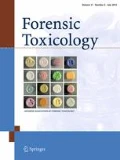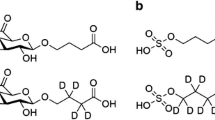Abstract
Because of its small detection window, uncovering drug-facilitated crime after gamma-hydroxybutyric acid (GHB) intake remains a problem. The aim of this experiment was to determine endogenous concentrations of GHB and GHB-O-β-glucuronide (GHB-Gluc) in plasma and urine samples and to compare them with concentrations after GHB intake in humans. Plasma and urine samples of volunteers (n = 50) who had never taken GHB during their lifetime (control group) were collected, and endogenous concentrations of GHB and GHB-Gluc were determined. In addition, plasma and urine samples of patients (n = 3) therapeutically taking sodium oxybate (GHB-sodium salt) were collected prior to and at different time points after the intake. GHB was determined via a liquid chromatography (LC)–tandem mass spectrometry system operated in multiple reaction monitoring mode. GHB-Gluc was detected by LC–quadrupole time-of-flight mass spectrometry. In plasma and urine samples of the control group (n = 50), endogenous concentrations of GHB-Gluc ranged from 0.011 to 0.067 mg/L and from 0.16 to 7.1 mg/L, respectively, while unconjugated GHB concentrations were less than 2 mg/L in both matrices. In contrast, after sodium oxybate administration, GHB concentrations increased markedly, and fell to below the commonly used cutoff value (plasma 4 mg/L and urine 10 mg/L) after 6–8 h in all patients. GHB-Gluc concentrations showed no significant time-dependent increase in plasma samples. In urine, GHB-Gluc concentrations increased after GHB intake, but were generally not higher than the endogenous concentrations of the control group. Therefore, it can be concluded that GHB-Gluc concentrations are not a suitable marker for extending the detection window after GHB intake.




Similar content being viewed by others
References
Cash CD (1994) Gammahydroxybutyrate: an overview of the pros and cons for it being a neurotransmitter and/or a useful therapeutic agent. Neurosci Biobehav Rev 18:291–304. doi:10.1016/0149-7634(94)90031-0
Busardò FP, Jones AW (2015) GHB pharmacology and toxicology: acute intoxication, concentrations in blood and urine in forensic cases and treatment of the withdrawal syndrome. Curr Neuropharmacol 13:47–70. doi:10.2174/1570159X13666141210215423
Gibson KM, Hoffmann GF, Hodson AK, Bottiglieri T, Jakobs C (1998) 4-Hydroxybutyric acid and the clinical phenotype of succinic semialdehyde dehydrogenase deficiency, an inborn error of GABA metabolism. Neuropediatrics 29:14–22. doi:10.1055/s-2007-973527
Dauvilliers Y, Arnulf I, Mignot E (2007) Narcolepsy with cataplexy. Lancet 369:499–511. doi:10.1016/S0140-6736(07)60237-2
Mamelak M, Scharf MB, Woods M (1986) Treatment of narcolepsy with gamma-hydroxybutyrate. A review of clinical and sleep laboratory findings. Sleep 9:285–289 (PMID: 3704454)
Jazz Pharmaceuticals (2015) Highlights of prescribing information. https://www.xyremrems.com/documents/XYREM_Prescribing_Information.pdf. Accessed 13 Dec 2016
Takahara J, Yunoki S, Yakushiji W, Yamauchi J, Yamane Y (1977) Stimulatory effects of gamma-hydroxybutyric acid on growth hormone and prolactin release in humans. J Clin Endocrinol Metab 44:1014–1017
Kam PCA, Yoong FFY (1998) Gamma-hydroxybutyric acid: an emerging recreational drug. Anaesthesia 53:1195–1198. doi:10.1046/j.1365-2044.1998.00603.x
Stell JM, Ryan JM (1996) Ecstasy and neurodegeneration. gamma-Hydroxybutyrate is a new recreational drug that may lead to loss of consciousness. BMJ 313(7054):424
Laborit H (1964) Sodium 4-hydroxybutyrate. Int J Neuropharmacol 3:433–451. doi:10.1016/0028-3908(64)90074-7
Madea B, Musshoff F (2009) Knock-out drugs: their prevalence, modes of action, and means of detection. Dtsch Arztebl Int 106:341–347. doi:10.3238/arztebl.2009.0341
Brenneisen R, Elsohly MA, Murphy TP, Passarelli J, Russmann S, Salamone SJ, Watson DE (2004) Pharmacokinetics and excretion of gamma-hydroxybutyrate (GHB) in healthy subjects. J Anal Toxicol 28:625–630. doi:10.1093/jat/28.8.625
Bay T, Eghorn LF, Klein AB, Wellendorph P (2014) GHB receptor targets in the CNS: focus on high-affinity binding sites. Biochem Pharmacol 87:220–228. doi:10.1016/j.bcp.2013.10.028
Abanades S, Farré M, Segura M, Pichini S, Pastor A, Pacifici R, Pellegrini M, de la Torre R (2007) Disposition of gamma-hydroxybutyric acid in conventional and nonconventional biologic fluids after single drug administration: issues in methodology and drug monitoring. Ther Drug Monit 29:64–70. doi:10.1097/FTD.0b013e3180307e5e
LeBeau MA, Christenson RH, Levine B, Darwin WD, Huestis MA (2002) Intra- and interindividual variations in urinary concentrations of endogenous gamma-hydroxybutyrate. J Anal Toxicol 26:340–346. doi:10.1093/jat/26.6.340
Andresen H, Sprys N, Schmoldt A, Mueller A, Iwersen-Bergmann S (2010) Gamma-hydroxybutyrate in urine and serum: additional data supporting current cut-off recommendations. Forensic Sci Int 200:93–99. doi:10.1016/j.forsciint.2010.03.035
Elliott SR (2004) Further evidence for the presence of GHB in postmortem biological fluid : implications for the interpretation of findings. J Anal Toxicol 28:20–26. doi:10.1093/jat/28.1.20
Erdmann F, Zandt D, Auch J, Schütz H, Weiler G, Verhoff MA (2006) Investigations concerning the threshold value between endogenous and exogenous GHB (liquid ecstasy) (in German with English abstract). Arch Kriminol 217:129–136 (PMID: 16910296)
Abanades S, Farré M, Segura M, Pichini S, Barral D, Pacifici R, Pellegrini M, Fonseca F, Langohr K, De La Torre R (2006) Gamma-hydroxybutyrate (GHB) in humans: pharmacodynamics and pharmacokinetics. Ann N Y Acad Sci 1074:559–576. doi:10.1196/annals.1369.065
Haller C, Thai D, Jacob III P, Dyer JE (2006) GHB urine concentrations after single-dose administration in humans. J Anal Toxicol 30:360–364. doi:10.1093/jat/30.6.360
Petersen IN, Tortzen C, Kristensen JL, Pedersen DS, Breindahl T (2013) Identification of a new metabolite of GHB: gamma-hydroxybutyric acid glucuronide. J Anal Toxicol 37:291–297. doi:10.1093/jat/bkt027
Wang X, Linnet K, Johansen SS (2016) Development of a UPLC–MS/MS method for determining γ-hydroxybutyric acid (GHB) and GHB glucuronide concentrations in hair and application to forensic cases. Forensic Toxicol 34:51–60. doi:10.1007/s11419-015-0285-6
Mehling L-M, Piper T, Dib J, Pedersen DS, Madea B, Hess C, Thevis M (2016) Development and validation of a HPLC–QTOF-MS method for the determination of GHB-β-O-glucuronide and GHB-4-sulfate in plasma and urine. Forensic Toxicol. doi:10.1007/s11419-016-0339-4
Petersen IN, Kristensen JL, Tortzen C, Breindahl T, Pedersen DS (2013) Synthesis and stability study of a new major metabolite of γ-hydroxybutyric acid. Beilstein J Org Chem 9:641–646. doi:10.3762/bjoc.9.72
Lott S, Musshoff F, Madea B (2012) Estimation of gamma-hydroxybutyrate (GHB) co-consumption in serum samples of drivers positive for amphetamine or ecstasy. Forensic Sci Int 221:98–101. doi:10.1016/j.forsciint.2012.04.009
Borgen LA, Okerholm RA, Lai A, Scharf MB (2004) The pharmacokinetics of sodium oxybate oral solution following acute and chronic administration to narcoleptic patients. J Clin Pharmacol 44:253–257. doi:10.1177/0091270003262795
Mamelak M, Escriu JM, Stokan O (1977) The effects of gamma-hydroxybutyrate on sleep. Biol Psychiatry 12:273–288
Broughton R, Mamelak M (1980) Effects of nocturnal gamma-hydroxybutyrate on sleep/waking patterns in narcolepsy–cataplexy. Can J Neurol Sci 7:23–31. doi:10.1017/S0317167100023659
King C, Rios G, Green M, Tephly T (2000) UDP-glucuronosyltransferases. Curr Drug Metab 1:143–161. doi:10.2174/1389200003339171
Foti RS, Fisher MB (2005) Assessment of UDP-glucuronosyltransferase catalyzed formation of ethyl glucuronide in human liver microsomes and recombinant UGTs. Forensic Sci Int 153:109–116. doi:10.1016/j.forsciint.2004.12.003
Crunelle CL, Neels H, Maudens K, De Doncker M, Cappelle D, Matthys F, Dom G, Fransen E, Michielsen P, De Keukeleire S, Covaci A, Yegles M (2016) Influence of body mass index on hair ethyl glucuronide concentrations. Alcohol Alcohol. doi:10.1093/alcalc/agw079
Acknowledgements
The authors would like to thank Ms. Alexandra Maas for making sample collection possible, Dr. Daniel Sejer Pedersen for providing the internal standard, and all volunteers for taking part in this study.
Author information
Authors and Affiliations
Corresponding authors
Ethics declarations
Conflict of interest
The authors declare that they have no conflict of interest.
Ethical approval
All procedures performed in this study involving human participants, who provided small amounts of blood and urine, were in accordance with the ethical standards of the institutional review board of the universities of Bonn and Münster and with the 1964 Helsinki declaration and its later amendments or comparable ethical standards.
Electronic supplementary material
Below is the link to the electronic supplementary material.
Rights and permissions
About this article
Cite this article
Mehling, LM., Piper, T., Spottke, A. et al. GHB-O-β-glucuronide in blood and urine is not a suitable tool for the extension of the detection window after GHB intake. Forensic Toxicol 35, 263–274 (2017). https://doi.org/10.1007/s11419-016-0352-7
Received:
Accepted:
Published:
Issue Date:
DOI: https://doi.org/10.1007/s11419-016-0352-7




